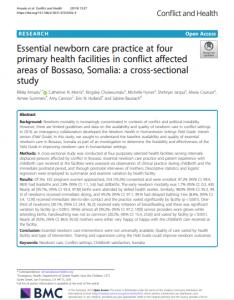
Background
Newborn mortality is increasingly concentrated in contexts of conflict and political instability. However, there are limited guidelines and data on the availability and quality of newborn care in conflict settings. In 2016, an interagency collaboration developed the Newborn Health in Humanitarian Settings Field Guide- Interim version (Field Guide). In this study, we sought to understand the baseline availability and quality of essential newborn care in Bossaso, Somalia as part of an investigation to determine the feasibility and effectiveness of the Field Guide in improving newborn care in humanitarian settings.
Methods
A cross-sectional study was conducted at four purposely selected health facilities serving internally displaced persons affected by conflict in Bossaso. Essential newborn care practice and patient experience with childbirth care received at the facilities were assessed via observation of clinical practice during childbirth and the immediate postnatal period, and through postnatal interviews of mothers. Descriptive statistics and logistic regression were employed to summarize and examine variation by health facility.
Results
Of the 332 pregnant women approached, 253 (76.2%) consented and were enrolled. 97.2% (95% CI: 94.4, 98.9) had livebirths and 2.8% (95% CI: 1.1, 5.6) had stillbirths. The early newborn mortality was 1.7% (95% CI: 0.3, 4.8). Nearly all [95.7%, (95% CI: 92.4, 97.8)] births were attended by skilled health worker. Similarly, 98.0% (95% CI: 95.3, 99.3) of newborns received immediate drying, and 99.2% (95% CI: 97.1, 99.9) had delayed bathing. Few [8.6%, (95% CI: received immediate skin-to-skin contact and the practice varied significantly by facility (p < 0.001). Onethird of newborns [30.1%, (95% CI: 24.4, 36.2)] received early initiation of breastfeeding and there was significant variation by facility (p < 0.001). While almost all [99.2%, (95% CI: 97.2, 100)] service providers wore gloves while attending births, handwashing was not as common [20.2%, (95% CI: 15.4, 25.6)] and varied by facility (p < 0.001). Nearly all [92%, (95% CI: 86.9, 95.5)] mothers were either very happy or happy with the childbirth care received at the facility